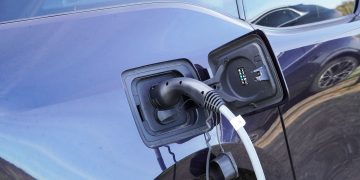Throughout August a variety of articles caught our attention that offer insightful information about the fast evolving world of electric vehicles.
It’s interesting to see how the sector continues to progress, particularly on the technological front, and how certain key stakeholders within the industry are fairing in their move towards achieving their net-zero ambitions.
Innovation continues apace with Tesla, BMW, National Express, BP and the UK Government all taking positive steps throughout the month to advance and decarbonise the industry.
Tesla & BMW’s New Approach to Car Batteries Is About to Transform Electric Vehicles
Electric vehicle designers and engineers face an ongoing challenge to find a balance between increasing an electric vehicle’s battery size and its range simultaneously – a concept known as the ‘weight spiral’. Increasing the battery size has multiple knock-on effects that require consideration.
Firstly, as the battery becomes bigger in order to provide greater driving ranges per charge it becomes heavier. The size of the brakes has to increase to compensate for this increased weight and because of the increased break size the car now needs bigger wheels. It’s a snowball effect that gathers greater momentum the denser and more powerful the battery is.
The complexity of this issue has required EV manufacturers to think outside of the metaphorical battery pack and find advanced ways to subsidise the relative relationship between battery weight and vehicle weight.
Solutions to this will ultimately enable the vehicles to travel further distances on a single charge without compromise, which is the key aim. So far EV manufacturers have developed solutions such as ‘cell-to-pack’, ‘cell-to-body’ and ‘cell-to-chassis’ batteries.
Tesla has been working on a cell-to-body battery construction which integrates the battery into the vehicle’s structure so that it serves a dual purpose – acting as the vehicle’s engine as well as its structural skeleton, thus providing power and support simultaneously. Tesla calls this next-gen battery design the ‘Structural Battery Pack’ which was revealed at their ‘Battery Day’ event in September 2020.
The graphic above puts the cell-to-body concept into clearer perspective. Think of a plane which has fuel tanks which are multi-purpose – functioning as both the engine and as the wings as opposed to being located within the confines of a traditional battery module.
Tesla has applied a similar principle to its starship (rocket) design, where the body itself is part of the fuel tank. This effectively uses the vehicle’s structure (specifically the underbody) as a battery, cancelling out the weight of the cell casing and turning it from dead weight into something valuable to the structure of the vehicle.
Moreover, the cell-to-body integration saves hundreds of parts according to Tesla, which decreases the vehicle weight by around 10%, further increasing the range of the vehicle’s battery whilst creating extra room in the vehicle since the batteries’ bulk has been redistributed in a streamlined fashion.
BMW in a similar vein to Tesla has detailed its battery strategy for its next generation electric vehicles, albeit with a slightly different approach to their battery construction strategy. BMW’s electric vehicle will break from prismatic cells and be powered by the same type of battery cells as Tesla: cylindrical cells by 2025. BMW’s tests have discovered that the volumetric energy density of the battery will be boosted by more than 20% versus the prismatic format currently used in its EVs, equating up to a 30% increase in range.
BMW will diverge from Tesla, in that they have opted for a cell-to-pack battery model – directly integrating cylindrical cells into a battery pack without the modules used in prior battery designs.
Similarly to Tesla’s cell-to-body strategy, this reduces the weight and volume of the battery, leading to increased range, particularly when compounded with the new cylindrical cells. This shift will also drastically reduce production costs and charging times – a 10% to 80% state of charge is predicted to take 30% less time.
BMW is further evolving the development, production and purchasing of their batteries to reduce manufacturing costs by up to 50% by switching to lithium iron-phosphate (LFP) cells, which are more cost-effective due to an increase in energy density. This is a positive step, particularly when compounded with the benefits the cylindrical cell format also brings, towards successfully reducing EV production costs down to the same level of internal-combustion vehicles.
All of these cost-effective innovations have the advantage of reducing the currently high production costs of Tesla and BMW’s next generation of EVs, which should positively impact their retail price. As shown in the next section of this article, the current entry price point for the cheapest EVs on the market are extortionate in comparison to their petrol counterparts – a barrier to adoption that should be less prevalent as these reduced costs begin to be passed on to the customer.
Read the full story > / Read the full story >
The Five Cheapest Brand New Electric Vehicles in The UK & US
Looking at the market for a new electric vehicle? Curious as to how much a new electric car currently costs? We’ve had a look at the cheapest brand new electric vehicles currently available on the market in both the UK and US to discern the current state of the electric car market from a buyer’s perspective. Interestingly UK prices start slightly higher than our friends over the pond, with the cheapest option on the market currently setting you back £22,335, while US prices start at £21,983. These prices are around double that of a new petrol car, with the cheapest currently on the market being the £11,500 Kia Picanto, which reaffirms the notion that affordability is currently one of the key barriers to EV adoption alongside availability and charging infrastructure.
The Five Cheapest Brand New Electric Vehicles in the UK:
- Fiat 500 Electric – £22,335
- MG4 (Morris Garages) – £25,995
- MG5 EV (Morris Garages) – £26,695
- Nissan Leaf – £28,995
- Vauxhall Corsa-e – £29,305
The Five Cheapest Brand New Electric Vehicles in the US:
- Chevrolet Bolt – $26,595
- Nissan Leaf – $28,895
- Mazda MX- $34,645
- Mini Cooper SE – $35,075
- Hyundai Kona Electric – $35,295
National Express’ First Zero-emission Coach To Launch Within Two Years
National Express’ Managing Director speaking to routeone magazine unveiled that they plan to include a zero-emission coach into their livery ‘within two years, and hopefully sooner,’ as the company progresses to make its entire fleet zero-emissions by 2035 – ahead of the UK’s net zero target of 2050.
The news solidifies the company’s commitment to decarbonising the environment and their ambitions to become the ‘UK’s most sustainable coach company… providing the most sustainable intercity network in the UK.’
UK Government’s New £20m Pilot Scheme Invests in 1,000 New Charging Points
The UK Government announced that it will invest in a £20m pilot scheme to install 1,000 electric vehicle charging points around England as part of a wider £450m scheme to encourage electric vehicle uptake across the country.

The new pilot dubbed the ‘Local EV Infrastructure’ scheme (LEVI) will see fast on-street charge points and large petrol station-esque charging hubs made available to the public across England in locations where residents do not own driveways or garages where home chargers would typically be fitted. Areas such as Barnet, Dorset, Durham, Kent, Lincolnshire, North Yorkshire, Nottinghamshire, Suffolk, and Warrington have been identified as key locations where there are currently barriers to accessible charging, making them ripe for investment.
Transport Minister, Trudy Harrison stated:
“We want to expand and grow our world-leading network of EV charge points, working closely with industry and local government, making it even easier for those without driveways to charge their electric vehicles and support the switch to cleaner travel.
“This scheme will help to level up electric vehicle infrastructure across the country, so that everyone can benefit from healthier neighbourhoods and cleaner air.”
AA president Edmund King signalled his delight at the news, believing that this will be a big ‘boost’ for those who cannot access charging points at home. He deems the scheme as a ‘positive step on the road to electrification.’
BP Opens First Charging Station for Electric Trucks
BP announced the official opening of its first ultra-fast charging station for medium and heavy-duty electric trucks. BP’s Aral brand fuel station is situated in Germany, Schwegenheim, near the major B9 road. The charging station features two 300kw ultra-fast chargers (CCS2) that are powered by 100% renewable energy.
Electric trucks seemed unthinkable a few years ago, but by teaming up with fellow innovators @DaimlerTruck, we're buzzing ⚡ to announce that the first truck charging points in Germany are live! Another important milestone on the road to electrification 🚚🔋🔌
— bp (@bp_plc) July 27, 2022
BP estimates that a heavy-duty electric truck can replenish around 150-200km during a driver’s mandatory 45-minute break. The station also offers food and drink, as well as toilet facilities so drivers can rest and replenish while their vehicle charges.
BP’s Executive Vice President, Customers & products Emma Delaney, stated:
“With the transition to electric vehicles well underway in Europe, we’re now seeing the move towards electric trucks. Truck manufacturers and truck fleet operators are demanding low carbon alternative fuels and electrification is an attractive option. Opening our first truck charging facilities at Schwegenheim is an important milestone for bp and the industry.
“Schwegenheim is a perfect example of what the industry needs – ultra-fast charging with safe charging bays for trucks, close to strategic road networks and a place where drivers can take a break and refresh with food and drinks.”





